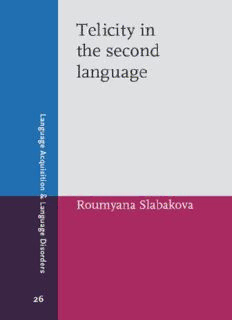
Telicity in the Second Language (Language Acquisition and Language Disorders) PDF
Preview Telicity in the Second Language (Language Acquisition and Language Disorders)
<ATSKSWVIUIDUEOZTIBYDOTEFLJWFHTECESHHCOOIEN"ETTRRTFI"DeG1O"l""5SiLH4"c0a"iT"tn>"y"gu"i2an2g0et"hAecqSuecisointidonLa&ngLuaangeg"uageDisorders,Volume26" TelicityintheSecondLanguage Language Acquisition & Language Disorders SeriesEditors HaraldClahsen UniversityofEssex LydiaWhite McGillUniversity EditorialBoard MelissaBowerman,MaxPlanckInstitutfürPsycholinguistik,Nijmegen KatherineDemuth,BrownUniversity NinaHyams,UniversityofCaliforniaatLosAngeles WilliamO’Grady,UniversityofHawaii JürgenMeisel,UniversitätHamburg MabelRice,UniversityofKansas LuigiRizzi,UniversityofSiena BonnieSchwartz,UniversityofDurham AntonellaSorace,UniversityofEdinburgh KarinStromswold,RutgersUniversity JürgenWeissenborn,UniversitätPotsdam FrankWijnen,UtrechtUniversity Volume26 TelicityintheSecondLanguage byRoumyanaSlabakova Telicity in the Second Language Roumyana Slabakova UniversityofIowa JohnBenjaminsPublishingCompany Amsterdam(cid:1)/(cid:1)Philadelphia TM Thepaperusedinthispublicationmeetstheminimumrequirements 8 ofAmericanNationalStandardforInformationSciences–Permanence ofPaperforPrintedLibraryMaterials,ansiz39.48-1984. LibraryofCongressCataloging-in-PublicationData Slabakova,Roumyana. Telicityinthesecondlanguage/RoumyanaSlabakova. p. cm.--(Languageacquisition&languagedisorders,issn0925–0123;v.26) Includesbibliographicalreferencesandindex. 1.Secondlanguageacquisition. 2.Grammar,Comparativeandgeneral--Aspect. I.Title. II.Series. P118.2.S58 2001 401’.93--dc21 00-140131 isbn9027224943(Eur.)/1588110389(US)(Hb;alk.paper) ©2001–JohnBenjaminsB.V. Nopartofthisbookmaybereproducedinanyform,byprint,photoprint,microfilm,orany othermeans,withoutwrittenpermissionfromthepublisher. JohnBenjaminsPublishingCo.·P.O.Box36224·1020meAmsterdam·TheNetherlands JohnBenjaminsNorthAmerica·P.O.Box27519·Philadelphiapa19118-0519·usa ThisbookisdedicatedtoBistra,Kamen,Bistra,andZlatko <ATSKSWVIUITUEOZTIBYADTEFLJWRFHTEESGHHCOOEE"ETTRRTTI"DaG1"b""5SLH"4"l0tea"oT"n>"c"go"u"f2aD2cg0Ooe"nCtAeIcNnqtFusO"isition&LanguageDisorders,Volume26" Table of contents Acknowledgements(cid:3)xiii Chapter1 Aspectandtheoriesofsecondlanguageacquisition(cid:3)1 1.1 Introduction(cid:3)1 1.2 Aspectualdistinctions(cid:3)3 1.2.1 Someterminology:Telicityandboundedness(cid:3)3 1.2.2 Whystudyaspect?(cid:3)5 1.3 Theoreticalframework(cid:3)6 1.3.1 Semanticuniversals(cid:3)7 1.3.2 Parameters(cid:3)8 1.4 TheoriesofaccesstoUG(cid:3)9 1.4.1 UGisnotactiveinadulthood(cid:3)10 1.4.2 Directaccess(cid:3)14 1.4.3 L1grammarastheinitialhypothesis(cid:3)16 Chapter2 Semanticandsyntactictreatmentsoftelicity(cid:3)21 2.1 Introduction(cid:3)21 2.2 Moreterminology(cid:3)21 2.2.1 Aspectualclasses(cid:3)21 2.2.2 Tests(cid:3)23 2.3 Aspectualsemantics(cid:3)25 2.3.1 Dowty’s(1979)aspectualcalculus(cid:3)25 2.3.2 Sub-eventstructure(cid:3)27 2.3.3 Aspectconstrual(cid:3)35 2.4 Aspectinsyntax(cid:3)41 2.4.1 Tenny(1987,1994)(cid:3)41 2.4.2 HaleandKeyser(1992,1993)(cid:3)46 viii Tableofcontents 2.4.3 Travis(1992,1994)(cid:3)52 2.4.4 Borer(1994,1998)(cid:3)56 2.5 Conclusion(cid:3)62 Chapter3 EnglishandSlavictelicity:Asyntacticaccount(cid:3)63 3.1 Introduction(cid:3)63 3.2 Englishphrasestructuretemplates(cid:3)64 3.3 Theaspect-relatedconstructions(cid:3)71 3.3.1 Onaunifiedaccountofresultatives,particles,anddouble objects(cid:3)72 3.3.2 Resultatives,particles,anddoubleobjectsareunifiedonthe basisofaspect(cid:3)73 3.3.3 Doubleobjectmaynotbepartofthecluster(cid:3)78 3.4 TheencodingofSlavicVPaspect(cid:3)82 3.4.1 Thecompletearrayofaspectualmorphemes(cid:3)82 3.4.2 Preverbsandverbclass(cid:3)87 3.4.3 Thephrasestructurepositionofpreverbs:Evidencefrom VP-internalscope(cid:3)88 3.5 Whatcanbeexplainedifpreverbsarehigherthanthederived objectposition?(cid:3)92 3.5.1 PerfectiveandimperfectiveVPsinthescopeof negation(cid:3)92 3.5.2 Verbalversusnominalmarkersoftemporalboundary(cid:3)94 3.5.3 Piñon’s(1993)ambiguityproblem(cid:3)96 3.6 Thetelicityparameterandtheaspect-relatedconstructionsin EnglishandBulgarian:Bringingitallbacktogetheragain(cid:3)99 3.7 Conclusion(cid:3)101 Chapter4 Firstandsecondlanguageacquisitionofaspect(cid:3)103 4.1 Introduction(cid:3)103 4.2 Firstlanguageacquisitionresearchonaspect(cid:3)104 4.2.1 Theearlyprimacyofaspecthypothesis(cid:3)104 4.2.2 Againsttheprimacyofaspecthypothesis(cid:3)106 4.2.3 Thelateprimacyofaspecthypothesis(cid:3)108 4.2.4 Againstthelateprimacyofaspecthypothesis(cid:3)112 Tableofcontents ix 4.3 Secondlanguageacquisitionofaspect(cid:3)114 4.4 Criticismoftheprimacyofaspecthypothesis(cid:3)125 4.4.1 Defectivetenseversusrelativizeddefectivetense(cid:3)125 4.4.2 Competenceversusperformanceissues(cid:3)126 4.4.3 Anewlookatthedata(cid:3)128 4.5 Thedistributionalbiashypothesis(cid:3)132 4.6 Viewpointaspectversussituationaspect(cid:3)135 4.7 Thetemplateapproachtolanguageacquisition(cid:3)137 4.8 Acquisitionoftheclusterofaspect-relatedconstructions(cid:3)140 4.9 Conclusion(cid:3)142 Chapter5 AnexperimentalstudyoftheL2acquisitionoftelicity(cid:3)143 5.1 Introduction(cid:3)143 5.2 Researchquestions(cid:3)143 5.3 Thetelicitymarkingparametersummarized(cid:3)146 5.4 Specifichypotheses(cid:3)147 5.5 Participants(cid:3)148 5.6 Assessmentofproficiencylevels(cid:3)150 5.7 Methodology(cid:3)152 5.7.1 TheAspecttask(cid:3)152 5.7.2 TheTranslationtask(cid:3)154 5.7.3 TheGrammaticalityJudgementtask(cid:3)155 5.7.4 TheStoriestask(cid:3)156 5.8 Results(cid:3)156 5.8.1 TheAspecttask(cid:3)157 5.8.2 TheTranslationtask(cid:3)160 5.8.3 TheGrammaticalityJudgementtask(cid:3)163 5.8.4 TheStoriestask(cid:3)170 5.9 Conclusion(cid:3)172 Chapter6 Discussion,implications,andconclusion(cid:3)173 6.1 Introduction(cid:3)173 6.2 Summaryoftheresults(cid:3)173
Description: